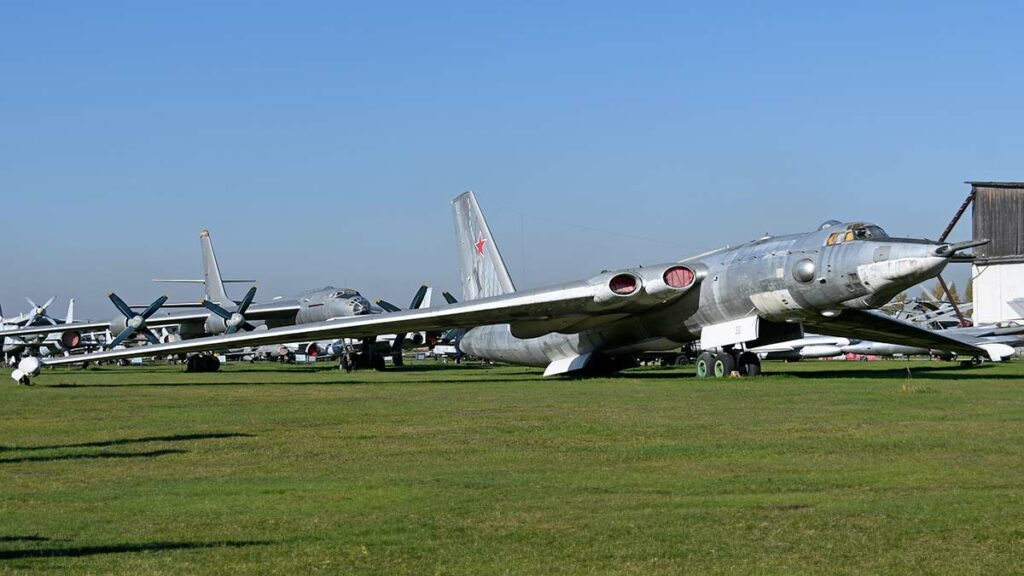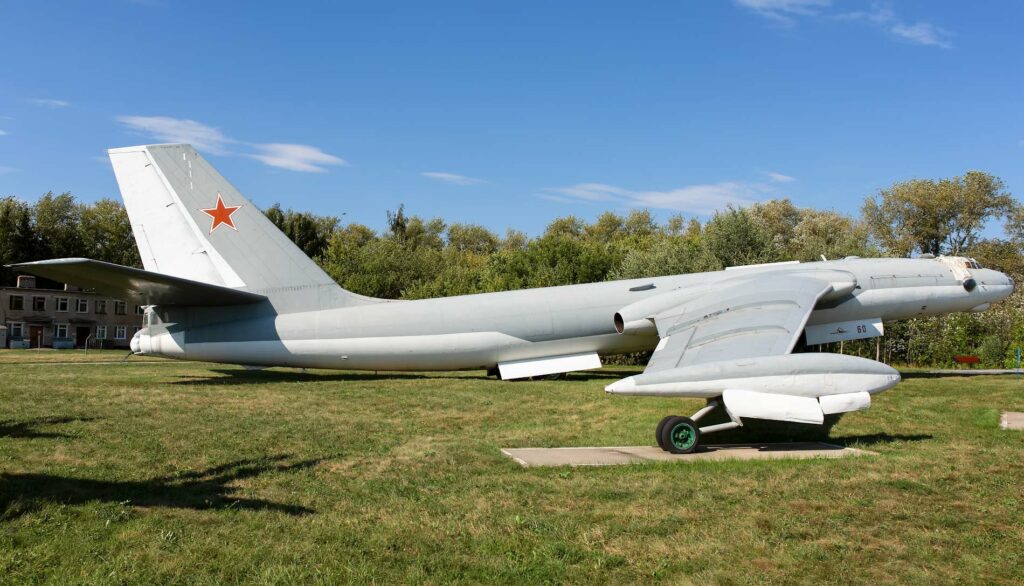The Myasishchev M-4 / 3M (Bison) is a Soviet long-range strategic bomber, nuclear-capable with four turbojet engines.
In brief
The Myasishchev M-4 / 3M, known by NATO as the Bison, was a strategic bomber developed by the Soviet Union during the Cold War. It was a response to the need for a long-range bomber capable of reaching the United States. The M-4 was notable for its four turbojet engines and ability to carry nuclear weapons. The 3M variant featured improved engines and avionics. This aircraft played a key role in the Soviet strategic bomber fleet, although it was eventually outclassed by advancements in missile technology and was retired from service in the late 20th century.
The Myasishchev M-4 / 3M, commonly referred to as the Bison, was a significant Soviet long-range bomber during the Cold War era.

History of Development
The Myasishchev M-4 / 3M, also known as the Bison, was a result of the strategic requirements of the Soviet Union during the early stages of the Cold War. In the context of escalating tensions with the Western powers, particularly the United States, the Soviet Union recognized the need for a long-range strategic bomber capable of delivering nuclear payloads to targets across the globe, including the continental United States.
The development of the Myasishchev M-4 began in the early 1950s, under the leadership of Vladimir Myasishchev. The project was initiated to match or surpass the capabilities of American bombers like the B-36 and the emerging B-52. The program, also known as “Subject 25,” was a part of the Soviet Union’s broader strategy to assert its military prowess and achieve strategic parity with the West.
The M-4 made its first flight on January 20, 1953, marking a significant milestone in Soviet aviation history. The aircraft was a showcase of Soviet ingenuity and engineering skills, featuring four powerful turbojet engines and a swept-wing design. The M-4, however, faced several challenges during its development, including issues with engine reliability and range limitations.
To address these shortcomings, an improved version of the aircraft, designated as 3M, was developed. The 3M variant featured upgraded Dobrynin VD-7 engines, which offered higher thrust and better specific fuel consumption than the original Mikulin AM-3A engines. This upgrade significantly enhanced the aircraft’s performance and extended its operational range.
The NATO codename “Bison” was assigned to the Myasishchev M-4 / 3M, reflecting the aircraft’s role and capabilities in the eyes of Western military analysts. The name Bison aptly symbolized the aircraft’s size, power, and strategic importance in the Soviet Union’s aerial arsenal.
Throughout its service life, the Myasishchev M-4 / 3M played a vital role in the Soviet Union’s strategic bombing and reconnaissance capabilities. It served as a deterrent against potential adversaries and demonstrated the USSR’s ability to project power far beyond its borders.
Design
The Myasishchev M-4 / 3M (Bison) featured a design that was revolutionary for its time, reflecting the technological advances and strategic priorities of the Soviet Union during the Cold War. The aircraft had a wingspan of 50.53 meters (165 feet 9 inches) and a length of 47.66 meters (156 feet 4 inches), with a wing area of 326.35 square meters (3,509 square feet). The empty weight was approximately 80,000 kilograms (176,370 pounds), and the maximum takeoff weight was around 184,500 kilograms (406,750 pounds).
The design of the Bison focused on delivering long-range strategic bombing capabilities. It was equipped with four Mikulin AM-3A turbojet engines in the original M-4 variant, which were later upgraded to Dobrynin VD-7 engines in the 3M variant. These engines provided the necessary thrust to achieve a maximum speed of 950 kilometers per hour (590 miles per hour) at altitude, with a service ceiling of 11,000 meters (36,100 feet) and a range of 8,000 kilometers (5,000 miles).
One of the key design features of the Bison was its ability to carry a significant payload. The aircraft was capable of carrying a variety of bombs, including two fusion bombs, general-purpose bombs up to 9 tonnes, and a combination of smaller bombs. It was also equipped with an OPB-11S optical bombsight and an RBP-4 Rubidy-MM-11 bombing/navigation radar for precision targeting.
The Myasishchev M-4 / 3M’s design included several innovations aimed at enhancing its performance and survivability. The aircraft featured extensive armor plating around critical areas to protect the crew and vital systems. The crew compartments were pressurized, and all crew members sat on downward-firing ejection seats. Avionics systems included a short-range navigation receiver, gyrocompass, radar altimeters, and various communication and identification systems.
The design of the Bison, while advanced for its time, also had its drawbacks. The heavy reliance on turbojet engines made the aircraft a gas-guzzler, limiting its operational range and endurance. Additionally, the size and complexity of the aircraft made it challenging to maintain and operate, especially in the harsh conditions often encountered by Soviet aircrews.
Overall, the design of the Myasishchev M-4 / 3M represented a balance between the need for long-range strategic bombing capabilities and the technological limitations of the era. It was a symbol of Soviet aviation prowess and played a crucial role in the Cold War strategic balance.
Performance
The performance of the Myasishchev M-4 / 3M (Bison) was a critical aspect of its role as a long-range strategic bomber. The original M-4 variant was equipped with Mikulin AM-3A turbojet engines, each delivering 19,280 pounds-force (lbf) of thrust. The upgraded 3M variant featured Dobrynin VD-7 turbojet engines, which provided improved thrust and fuel efficiency.
The Bison had a maximum speed of 950 kilometers per hour (590 miles per hour) at altitude, making it one of the fastest bombers of its time. Its service ceiling was 11,000 meters (36,100 feet), allowing it to operate above most enemy air defenses. The aircraft had a significant range of 8,000 kilometers (5,000 miles), enabling it to strike targets deep within enemy territory.
In terms of armament, the Bison was capable of carrying a wide array of weapons. It could be equipped with two fusion bombs for strategic nuclear strikes. Alternatively, it could carry various combinations of general-purpose bombs, ranging from large 9-tonne FAB-9000 bombs to smaller 100-kilogram FAB-100 bombs. This versatility allowed the Bison to perform both nuclear and conventional bombing missions.
The aircraft’s bomb drop was directed by the OPB-11S optical bombsight and the RBP-4 Rubidy-MM-11 bombing/navigation radar, which could be linked for precise targeting. The Bison also had the capability to carry naval mines and rocket-powered torpedoes, although these were less commonly used.
In comparison to its contemporaries, the Bison had advantages and disadvantages. It was faster and could carry a heavier warload than the Tupolev Tu-95 Bear, but the Bear had a longer operational range. The Bison’s reliance on turbojet engines made it less fuel-efficient and limited its endurance compared to turbo-prop powered bombers.
Despite these limitations, the Myasishchev M-4 / 3M was a formidable aircraft in its time. It represented a significant step forward in Soviet bomber capabilities and played a crucial role in the strategic balance during the Cold War.
Variants (300 words)
The Myasishchev M-4 / 3M (Bison) had several variants, each designed for specific roles and improvements over the base model. The key variants included:
M-4 (Bison-A): The original mass-produced version of the bomber, with 32 aircraft built. It was equipped with Mikulin AM-3A engines.
3M (Bison-B): An improved version featuring Dobrynin VD-7 engines for better performance. The first prototype was converted from an M-4.
3MD (Bison-C): A variant designed for carrying cruise missiles like the P-6, KSR, or Kh-10, with only nine built before production ceased.
3MS-1 and 3MN-1 (Bison-B): New production long-range bombers with either old (S) or new (N) engines, with an emphasis on improved reliability and avionics upgrades.
3MSR-1 and 3MSN-1 (Bison-B): Similar to the 3MS-1 and 3MN-1 but with additional avionics upgrades.
M-4-2 (Bison-A): M-4 production aircraft converted to in-flight refueling tankers.
3MS-2 (Bison-B): New production in-flight refueling tanker aircraft with old engines.
These variants represented the evolution of the Bison’s design and capabilities, adapting to the changing needs of the Soviet military and the technological advancements of the time.

Military Use and Combat
The Myasishchev M-4 / 3M (Bison) served primarily in the Soviet Air Force and Navy, playing a crucial role in the strategic bomber fleet. Its primary mission was long-range strategic bombing, with the capability to deliver nuclear and conventional payloads. The Bison’s armament included up to 9 x 23mm NR-23 or AM-23 cannons for self-defense, and it could carry up to 52,910 pounds of munitions, including nuclear-tipped bombs and cruise missiles.
During its service life, the Bison was not actively engaged in combat operations or conflicts. However, its presence as a strategic bomber capable of reaching targets across the globe, including in North America, played a significant role in the Cold War’s strategic deterrence. The aircraft’s ability to conduct aerial refueling extended its operational range and versatility, further enhancing its strategic value.
The Bison’s military use was also characterized by its participation in various reconnaissance and surveillance missions. Its capabilities in intelligence, surveillance, and reconnaissance (ISR) missions were critical in assessing enemy threat levels, strength, and movements.
The Bison’s competition primarily came from other strategic bombers of the era, such as the American B-52 Stratofortress and the Soviet Tupolev Tu-95 Bear. While the B-52 had a greater payload capacity and range, the Bison was faster and could carry a heavier warload than the Bear.
The Myasishchev M-4 / 3M was eventually phased out of service, with the last tankers being struck off charge in 1994. The retirement of the Bison was influenced by the advancement of missile technologies and the emergence of arms limitation treaties in the 1980s. Its replacement in the strategic bomber role was primarily by more advanced aircraft such as the Tupolev Tu-160 Blackjack.
Although the Bison did not see combat, its role as a strategic bomber and deterrent during the Cold War was significant. It demonstrated the Soviet Union’s ability to project power and maintain a credible nuclear deterrent against potential adversaries.
The Myasishchev M-4 / 3M (Bison) was a landmark in Soviet aviation history, representing a significant advancement in long-range strategic bombing capabilities during the Cold War. Although it had its limitations, the Bison played a crucial role in the strategic balance of the era and served as a key component of the Soviet Union’s military might. Its development, design, and performance reflected the technological and strategic challenges of the time, and its legacy continues to be remembered as a symbol of Soviet aerospace achievement.
Back to the Bombers section.